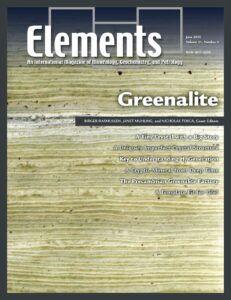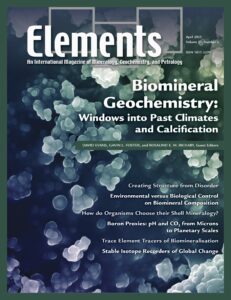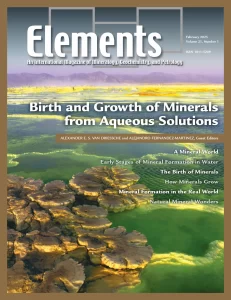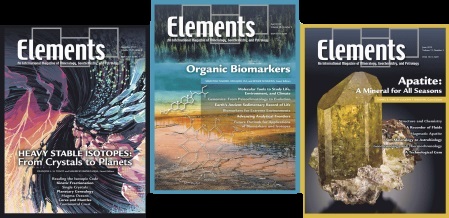v21n3 From The Editor
By Janne Blichert-Toft, Sumit Chakraborty, Tom Sisson, Carol Frost, and Esther Posner | June, 2025

The early Earth, like countless other wet rocky planets, was predestined to make greenalite given the environments and conditions that prevailed in the ancient hydrosphere. The magma-driven circulation of seawater through ancient mafic/ultramafic crust and subsequent venting of hydrothermal fluids into oxygen-free oceans produced ideal conditions for the formation of vast plumes of nanoparticulate greenalite. This process is now seen by some as a key driver in the deposition of banded iron formations, chemical sedimentary rocks ubiquitous on the young Earth and host-rocks of most of the world’s iron deposits. At first glance, greenalite is easily overlooked. Indeed, its minute size and inconspicuous optical properties allowed its true extent to go unnoticed until the use of nanoscale microanalysis in the last decade.
v21n2 From The Editor
By Janne Blichert-Toft, Sumit Chakraborty, Tom Sisson, Carol Frost, and Esther Posner | April, 2025

Marine calcium carbonate biominerals, especially the shells and skeletons produced by molluscs, corals, and the immeasurably numerous calcifying phytoplankton and zooplankton, are of both societal and environ mental importance for two key reasons. Firstly, the mineralised remains of these organisms are one of the largest longterm sinks of carbon on Earth’s surface. Secondly, and perhaps more practically, the (trace) element and isotopic composition of these biominerals probably represents the most widely applied tool for quantitatively reconstructing past environmental conditions on timescales from days to millions of years. It has been known for some time that the processes of biomineralisation imprint on these ‘proxy’ systems, shifting their behaviour away from thermodynamic equilibrium, such that they typically require empirical calibration to an environmental variable of interest.
v21n1 From The Editor
By Sumit Chakraborty | February, 2025

This issue of Elements is dedicated to the fascinating topic of mineral nucleation and growth, in which various authors explore the emerging ideas of non-classical nucleation processes and how they are altering our classical view of mineral formation processes. Contributors emphasize how these processes, including precursor phases, amorphous intermediates, and multi-step pathways, challenge conventional models of mineral formation. Evidence both from experimental studies and theoretical models is presented, showing that nucleation often occurs via disordered or non-equilibrium states, where clusters or aggregates of molecules form before evolving into well-ordered crystalline structures.

